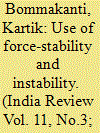| Srl | Item |
| 1 |
ID:
117434


|
|
|
|
|
| Publication |
2012.
|
| Summary/Abstract |
It has often been alleged, most recently in the recommendations of India's National Advisory Council (NAC), that the Indian state promotes, or is complicit in, Hindu-Muslim violence for political or electoral reasons. But the evidence for the claim has historically been sketchy. In StevenWilkinson's work, Votes and Violence, the argument is that the evidence supporting state complicity is systematic.We examine this argument and find it to be fundamentally flawed.
|
|
|
|
|
|
|
|
|
|
|
|
|
|
|
|
| 2 |
ID:
117432


|
|
|
|
|
| Publication |
2012.
|
| Summary/Abstract |
In the past 60 years, India-China relations have oscillated between friendship, hostility and indifference. In recent times, both countries have started competing for global economic gains and political status. In light of these events, the objective of this article is to analyze various strategies used by China against India, and India's policy response to these strategies. The article evaluates the process of foreign policy decision making in India, and traces the historical evolution of India's foreign policy towards China. It then deconstructs China's foreign policy towards India, and provides the rationale behind its strategies. The article suggests that after initial engagement with India on the question of boundary disputes, Chinese foreign policy has undergone a dramatic shift since 2007. It specifically evaluates the twin Chinese tactics of military incursions and denial of legitimacy to the Indian territories of Arunachal Pradesh and Ladakh. Based on an analysis of China's previous boundary disputes resolution record with neighbors, these tactics are identified as an extension of China's new strategy for resolving such disputes. The article concludes by suggesting various policy options available to India to counter China's new strategy on the Sino-Indian border.
|
|
|
|
|
|
|
|
|
|
|
|
|
|
|
|
| 3 |
ID:
117433


|
|
|
|
|
| Publication |
2012.
|
| Summary/Abstract |
This article evaluates the source of instability and stability in the India-Pakistan dyad and the Sino-Indian dyad. Challenging the dominant thesis that "means determine ends," the article posits that the use of force by Pakistan renders the India-Pakistan relationship unstable, whereas the Sino-Indian relationship is significantly more stable because of the absence of force. The difference in the state of stability in both dyads is because the weaker state, Pakistan in its conflict with India has failed to accept the verdict of its military defeats. This failure to internalize irreversible military outcomes makes Pakistan particularly susceptible to employing forcible solutions to settle its dispute with India over Kashmir. The reality reverses in the Sino-Indian territorial dispute, in that India has implicitly accepted its military loss against China in 1962 and charted a diplomatic pathway in resolving the boundary dispute.
|
|
|
|
|
|
|
|
|
|
|
|
|
|
|
|